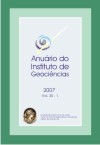Analysis of cyanobacterial composition in pustuled microbial Mats in saline, Araruama, Rio de Janeiro
DOI:
https://doi.org/10.11137/2007_1_175-180Abstract
Julieta saline receives water from lagoa de Araruama, which is located in the state of Rio de Janeiro, to the East of the city of Araruama and to the west of the city of Cabo Frio, between 22º49' and 22º57' S latitude and 42º00' and 42º23' W longitude. It is composed by a series of soil tanks obtained by natural excavation, where water gradually concentrates through natural evaporation until salt precipitation. The reservoirs can be divided in three types, according to their activity: cargo, evaporator and crystallizer tanks. The process of making such reservoirs waterproof is enabled by a fine layer of algae which is formed naturally with the passing of time. This study is based on monthly collects within the period ranging from May, 2004 to October, 2004, along three collection stations set up in different saline reservoirs. To identify the microbic composition, fresh, semi-permanent and permanent laminae were obtained and their analysis were performed by means of optical microscopy. The analysis revealed a total of twenty cyanobacterial types. In all layers, a predominant amount of oval spherical forms was observed. The predominance of cyanobacteria is justified by the fact that they are carriers of high morphological adaptations which enables them to survive in various types of environments and be predominant in hypersaline sites.Downloads
Download data is not yet available.
Downloads
Published
2007-01-01
How to Cite
Silva, L. H. da S. e (2007) “Analysis of cyanobacterial composition in pustuled microbial Mats in saline, Araruama, Rio de Janeiro”, Anuário do Instituto de Geociências. Rio de Janeiro, BR, 30(1), pp. 175–180. doi: 10.11137/2007_1_175-180.
Issue
Section
Article
License
This journal is licensed under a Creative Commons — Attribution 4.0 International — CC BY 4.0, which permits use, distribution and reproduction in any medium, provided the original work is properly cited.















